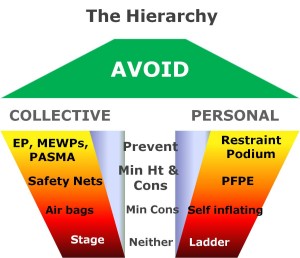The Work at Height Hierarchy is at the heart of all that we do. It comes directly from the Work at Height Regulations, and it explains the order in which we should consider the options and alternatives for working at height.
The HSE represent the hierarchy as a “matrix” table, with options and alternative suggestions at each level, however they do not visualise the most important first step .. the option to Avoid the need to work at height in the first place. This we call the “Designer Challenge.”
At Higher Safety we represent the work at height hierarchy thus :-

The Avoid option includes using remote control devices or remote imaging to inspect (camera on a helicopter), or simply doing the work another way, or in another sequence of operations.
Collective Fall Prevention includes all manner of collective (everyone is protected) measures that prevent falls. These include edge protection, scaffolding, BMUs, cradles, MEWPs, advanced guard rails, working platforms.
Personal (or Individual) Fall Prevention includes versions of the previous solutions types designed for a single person. It also includes the use of harness and lanyard solutions in such a way that the user cannot get into a position from which to fall, often called Restraint systems. Rope Access falls into this category, as the user is in suspension (although he will always have a secondary back up system that will minimise his fall in the event of equipment failure).
Minimise Height and Consequence used to be called Fall Arrest, however this term often led to a casual attitude to fall distance and the level of injury that could result. The new term describes the intention of the solution, clarifying the need to minimise any fall distance and soften any landing.
Collective Minimise Height & Consequence is the next level in the hierarchy, and is almost exclusively the domain of safety net based solutions. These should always be rigged as close as possible to the fall level to minimise the fall distance.
Personal Minimise Height & Consequence is the term for the various types of harness and lanyard solution. These should always be specified to minimise any potential free fall, by raising the anchor position and shortening the lanyard length. Inertia blocks (self retracting life lines) positioned overhead can be a very effective solution at this level.
When the potential fall distance cannot be influenced, such as when working next to tidal water, the next level within the hierarchy would be to Collectively Minimise Consequence. Air bags and Bean Bags fall into this category, as they do little to reduce the fall distance, which is a matter of judgement. If considering working over tidal water, a life boat would also be a collective measure. Personal measures at this level in the hierarchy include injury reduction systems like energy absorbing jackets (such as used in horse riding and motor cycle racing), and life jackets for our tidal water application.
The lowest level in the hierarchy is to do nothing. A stage can be a Collective work environment where there are no measures introduced to protect the performers from a fall. Trestles, unguarded platforms, hop-ups can all be considered collective measures, and ladders and stilts are examples of personal measures at this level in the hierarchy. There as argument that collective measures that do “nothing” are even worse than personal measures that do nothing, in terms of the level and extent of potential injury.
This hierarchy should be used to guide and inform all decisions concerning the selection of work at height solutions. This is certainly the case within Higher Safety.
